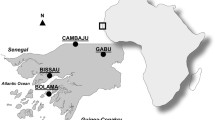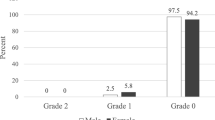Abstract
Iodine deficiency, which is most visibly indicated by goiter, is highly prevalent in Indonesia. Since 1994, Indonesia has a decree that all salt used for human, livestock, and industry must be iodized. However, despite the increased distribution of iodized salt, pockets with significantly higher prevalence of goiter still remain. This situation may be consequence of selenium (Se) deficiency. This study aimed to assess the Se level in the environment of goiter prevalent areas. Five hundred eleven school children participated in this study. Goiter was measured using both ultrasound and palpation. Ninety-nine eggs were collected from free-living chicken in 11 villages, and the Se contents of egg yolk and egg white were determined by neutron activation analysis. In the villages studied, Se concentration in egg yolk ranged from 0.15 to 1.52 Μg/g and in egg white from 0.18 to 2.97 Μg/g. The prevalence of goiter measured by palpation ranged from 18.4% to 70% and by ultrasound from 0% to 100%. Because of the inconsistency of goiter rate measured by palpation and ultrasonography, the question remains whether low availability of Se in the environment might be an additional contributing factor for goiter.
Similar content being viewed by others
References
ICCIDD/UNICEF/WHO, Global prevalence of iodine deficiency disorders. Micronutrient Deficiency Information System, Working Paper #1, MDIS, WHO, Geneva (1993).
R. Djokomoelyanto, The effect of severe iodine deficiency: a study on a population in central Java, Indonesia, Thesis, Diponegoro University, Semarang, Indonesia (1974).
Soekirman, I. Tarwotjo, I. Jus’at, G. Sumodiningrat, and F. Jalal, Economic growth, equity and nutritional improvement in Indonesia, UN Administrative Committee on Coordination/Subcommittee on Nutrition ACC/SCN, Adelaide (1992).
Ministry of Health, Nutrition in Indonesia: problems, trends, policy and programs, Jaringan Informasi Pangan dan Gizi, Directorate of Nutrition, Jakarta. Indonesia, Vol. I, No. 2 (1993).
B. S. Hetzel, The prevalence and control of iodine deficiency disorders, Administrative Committee on Coordination/Subcommittee on Nutrition ACC/SCN, FAO, Rome (1993).
Iodized salt consumption at the household level, Central Bureau of Statistics (BPS) and UNICEF, Jakarta (1995).
P. Heywood, Iodine deficiency disorders control program: issues and recommendations, World Bank, Washington, DC (1995).
S. M. Filteau, K. R. Sullivan, U. S. Anwar, Z. R. Anwar, and A. M. Tomkins, Iodine deficiency alone cannot account for goitre prevalence among pregnant women in Modhupur, Bangladesh,Eur. J. Clin. Nutr. 48, 293–302 (1994).
P. P. Bordoux, Role of goitrogens in the etiology of iodine deficiency disorders, inTrace Elements in Man and Animals — 9. Proceedings of the Ninth International Symposium on Trace Element in Man and Animals, P. W. F. Fisher, M. R. L’Abbé, K. A. Cockell, and R. S. Gibson, eds., National Press, Ottawa, Canada, pp. 152–155 (1997).
J. R. Arthur, Selenium biochemistry and function, inTrace Elements in Man and Animals-9. Proceedings of the Ninth International Symposium on Trace Element in Man and Animals, P. W. F. Fisher, M. R. L′Abbé, K. A. Cockell, and R. S. Gibson, eds., National Press, Ottawa, Canada, pp. 1–10 (1997).
G. J. Beckett, S. E. Beddows, P. C. Morrice, F. Nicol, and J. R. Arthur, Inhibition of hepatic deiodination of thyroxine caused by selenium deficiency in rats,Biochemistry 248, 443–447 (1987).
P. Goyens, J. Golstein, B. Nsombola, H. Vis, and J. E. Dumont, Selenium deficiency as a possible factor in the pathogenesis of myxoedematous endemic cretinism,Acta Endocrinol. (Copenh.)114, 497–502 (1987).
J. B. Vanderpas, B. Contempre, N. L. Duale, W. Goossens, N. Bebe, R. Thorpe, et al., Iodine and selenium deficiency associated with cretinism in northern Zaire,Am. J. Clin. Nutr. 52, 1087–1093 (1990).
C. H. Thilly, B. Swennen, P. Bourdoux, K. Ntambue, R. Moreno-Reyes, J. Gillies, et al., The epidemiology of iodine-deficiency disorders in relation to goitrogenic factors and thyroid-stimulating-hormone regulation,Am. J. Clin. Nutr. 57(Suppl.), 267S-270S (1993).
T. Ma, J. Guo, and F. Wang, The epidemiology of iodine-deficiency diseases in China,Am. J. Clin. Nutr. 57(Suppl.), 264S-266S (1993).
B. Contempre, J. E. Dumont, N. Bebe, C. H. Thilly, A. T. Diplock, and J. Vanderpas, Effect of selemium supplementation in hupothyroid subjects of an iodine and selenium deficient area: the possible danger of indiscriminate supplementation of iodinedeficient subjects with selenium,J. Clin. Endocrinol. Metabol. 73, 213–215 (1991).
J. B. Vanderpas, B. Contempré, N. L. Duale, H. Deckx, N. Bebe, A. O. Longombé, et al., Selenium deficiency mitigates hypothyroxinemia in iodine-deficient subjects,Am. J. Clin. Nutr. 57(Suppl.), 271S-275S (1993).
G. J. Beckett, F. Nicol, P. W. H. Rae, S. Beech, Y. Guo, and J. R. Arthur, Effects of combined iodine and selenium deficiency on thyroid hormone metabolism in rats,Am. J. Clin. Nutr. 57(Suppl.), 240S-243S (1993).
M. Ruz, J. Codoceo, J. Galgani, C. Bosco, S. Muzzo, L. Leiva, et al., Zincselenium-iodine and thyroid function, Proceedings of the 16th International Congress of Nutrition, Montreal, Canada (1997).
G. Gissel-Nielsen, U. C. Gupta, M. Lamand, and T. Westermarck, Selenium in soils and plants and its importance in livestock and human nutrition,Adv. Agronom. 37, 397–460 (1984).
O. A. Levander, A global view of selenium nutrition,Annu. Rev. Nutr. 7, 227–250 (1987).
H. Robberecht, H. Benemariya, P. Van Dael, and H. Deelstra, Mineralisation procedures and determination of selenium in egg white, egg yolk and shells of different eggs,Belg. J. Food Chem. Biotechnol. 42, 147–153 (1987).
P. BrÄtter, V. E. Negretti de BrÄtter, U. Rosik, and C. Mendez, The utilization of hens’ eggs as a selenium monitor in epidemiological studies, inTrace Elements in Man and Animals 6, L. S. Hurley, C. L. Keen, B. Lonnerdal, and R. B. Rucker, eds., Plenum, New York, pp. 167–169 (1988).
M. Ruz, J. Codoceo, S. Hurtado, L. Muñoz, and N. Gras, Characterization of the regional distribution of selenium in Chile using selenium in hens’ eggs as a monitor,J. Trace Elements Med. Biol. 9, 156–159 (1995).
WHO/UNICEF/ICCIDD,Indicators for Assessing Iodine Deficiency Disorders and Their Control Programmes, review version, WHO, Geneva (1994).
N. Gras, M. Thieck, L. Munoz, and S. Hurtado, Seasonal and geographical variability in some trace elements of Pacific oysters (Crassostrea Gigas) cultured in two different bay of Northern Chile,J. Radioanal. Nucl. Chem. 161, 135–146 (1992).
N. Gras, L. Muñoz, V. Cassorla, and P. Castillo, Homogeneity preliminary study of in-house reference material using neutron activation analysis and X-ray fluorescence,Fresenius J. Anal. Chem. 345, 154–165 (1993).
K. Heydorn and B. Griepink, Selection of reference methods for the determination of selenium in biological materials,Fresenius J. Anal. Chem. 338, 287–292 (1990).
Council for International Organizations of Medical Sciences,Guidelines for Ethical Review of Epidemiological Studies, CIOMS, Geneva (1991).
M. Ruz, J. Codoceo, A. Rebolledo, S. Hurtado, L. Muñoz, and N. Gras, Selenium intake and selenium status of Chilean adults from three distinct geographical locations,J. Trace Element Exp. Med. 8, 98 (1995).
National Academy of Sciences,Recommended Dietary Allowances, 10th ed., National Academy of Sciences, Washington, DC (1989).
L. V. H. Pardede, W. Hardjowasito, R. Gross, D. H. S. Dillon, O. S. Totoprajogo, M. Yosoprawoto, et al., Urinary iodine excretion is the most appropriate outcome indicator for iodine deficiency at field conditions at district level,J. Nutr. 128, 1122–1126 (1998).
Author information
Authors and Affiliations
Rights and permissions
About this article
Cite this article
Untoro, J., Ruz, M. & Gross, R. Low environmental selenium availability as an additional determinant for goiter in East Java, Indonesia?. Biol Trace Elem Res 70, 127–136 (1999). https://doi.org/10.1007/BF02783854
Received:
Accepted:
Issue Date:
DOI: https://doi.org/10.1007/BF02783854




